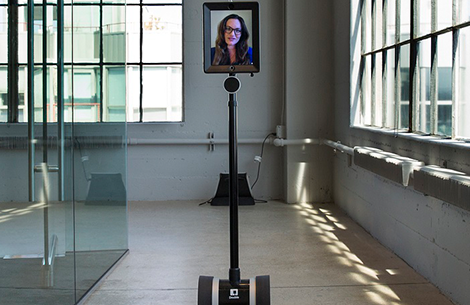Using telepresence robotics technology by Double Robotics and others, organizations are virtually sending their employees on client meetings and speaking engagements every day. But it’s not all sunshine and rainbows.
Telepresence is one of the few commercial applications of robotics technology that I’ve been genuinely excited about. Now that remote work is significantly on the rise, I view telepresence as a terrific means for professionals to virtually project themselves into an engaging human office environment.
Since I don’t have a telepresence robot myself yet, I checked out some opinions from those who have used them. Do the current machines live up to the hype, and are they a nightmare for IT staff to manage and secure?
In theory
Over at TechCrunch last month, Peter Hirst wrote about his colleague at MIT Sloan Executive Education, Paul McDonagh-Smith. Paul’s based in London, but his telepresence robot from Double Robotics allows him to present at a conference in Singapore first thing in the morning, then have a business meeting in Cape Town, South Africa and later that afternoon, meet with team members on the MIT campus in Cambridge, Massachusetts.
“In our office, telepresence robots are no longer a novelty, but an everyday tool we’ve been using to enable our remote team members to be more engaged,” said Hirst. “Double’s robot units are available regularly for team meetings or one-on-one visits. We all enjoy the ability to be truly present in our interactions with colleagues and clients — an experience that feels much more natural and personal than a phone call or a videoconference.”
In practice
Emily Dreyfuss is a remote worker at Wired. She lives in Boston, but most of her colleagues are in an office in San Francisco, and she was feeling left out. Her boss bought her Double Robotics’ creatively named Double, which sells for around $2500. The telepresence robot was Dreyfuss’ physical embodiment at headquarters. Instead of legs, she moved on gyroscopically stabilized wheels. Instead of a face, she had an iPad screen. Instead of eyes, a camera with no peripheral vision. Instead of a mouth, a speaker. And instead of ears, a tinny microphone.
At first, Dreyfuss was enamored with the experience. “It’s thrilling. I am in the office! There is the kitchen! There is Sam! Hi, everyone! I am here!” she exclaimed. Her robot, nicknamed Embot, attended meetings. “Plunked at the end of the conference table, my iPad head tracked the conversation, listening.”
Although Embot put Dreyfuss physically in the office, her co-workers could only see her face and not her body, and therefore were not constantly reminded how pregnant she was. “The visual reminder of my changed condition was not in their faces,” she said. “I have worked at places before where women start getting treated differently when their bellies show.
Dreyfuss realized, however, that current telepresence technology has its limitations. For one thing, people were always touching her robotic body without asking, either to help her move if she got stuck or just because they felt it. It was awkward for her – and her colleagues too. As one reported: “You know, when Joe lifted you up and carried you – with your face on the screen, it looked really inappropriate. Like he was cradling you in his arms.”
Embot was also a little rough around the edges technology wise. Dreyfuss couldn’t hear meetings very well. Robots, of course, live off power and and Wi-Fi, and signal strength proved to be a big problem.
Security implications of telepresence robots
IT professionals probably look at telepresence robots as yet another thing to worry about, and their concerns are not unfounded. For one thing, if you have any kind of sensitive intellectual property floating around your office, having a remote-controlled camera and microphone zipping around, unintentionally transferring all kinds of data across the Internet in real-time, probably isn’t the best idea.
Then, there’s the software that runs the robots. To put it simply, it has bugs. Cisco recently got a lot of press for the hacking of its telepresence software. Attackers exploited an improper XML API by sending crafted HTTP requests to bypass authentication and execute unauthorized configuration changes and commands on the system. Cisco patched the software, but the security breach was significant.
The bottom line? Telepresence robots do have the potential to make virtual work a livelier, more fun endeavor, but they aren’t so sophisticated that you’ll forget that you’re essentially an iPad on a stick. Those expecting a vast improvement over regular videoconferencing may be disappointed.
As with any new technology that makes its way into the enterprise, IT professionals should keep a close watch on who in the organization is bringing in telepresence robots and how they are being set up, maintained, and secured. Challenges are similar to BYOD, and addressing them adequately might take more IT bandwidth than anyone wants to spend. And most importantly, protocols governing use should be set up right away so your organization isn’t hand-delivering proprietary information to the world.
Image courtesy of Wired
Not Authorized
You are currently not authorized to access this section.
Please contact your Administrator to change your authorization settings.
Please contact your Administrator to change your authorization settings.

Telepresence: Boon for the Virtual Digital Workplace and Bane for IT?
September 19, 2016

